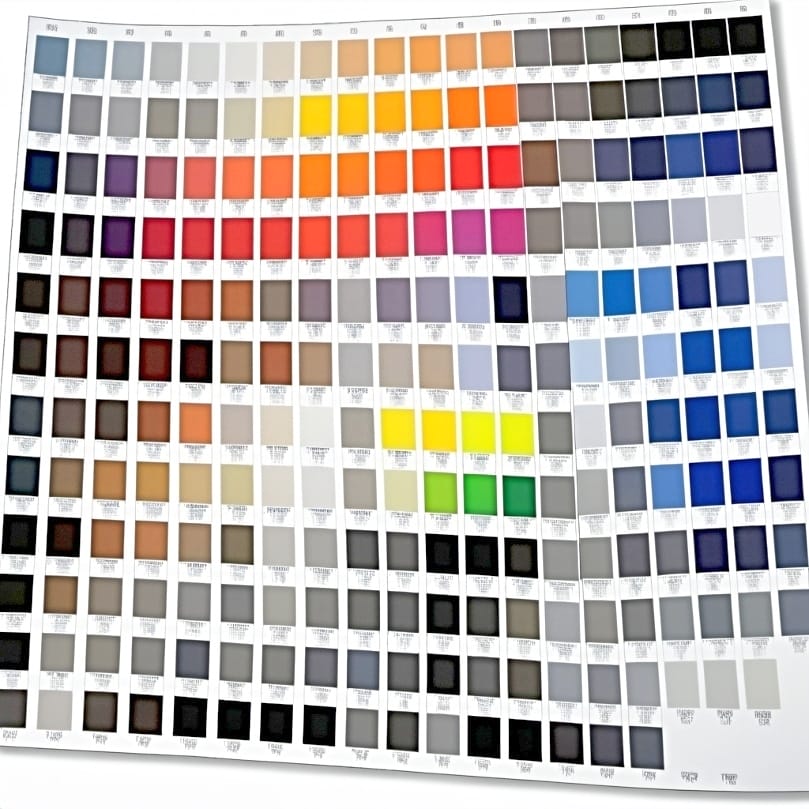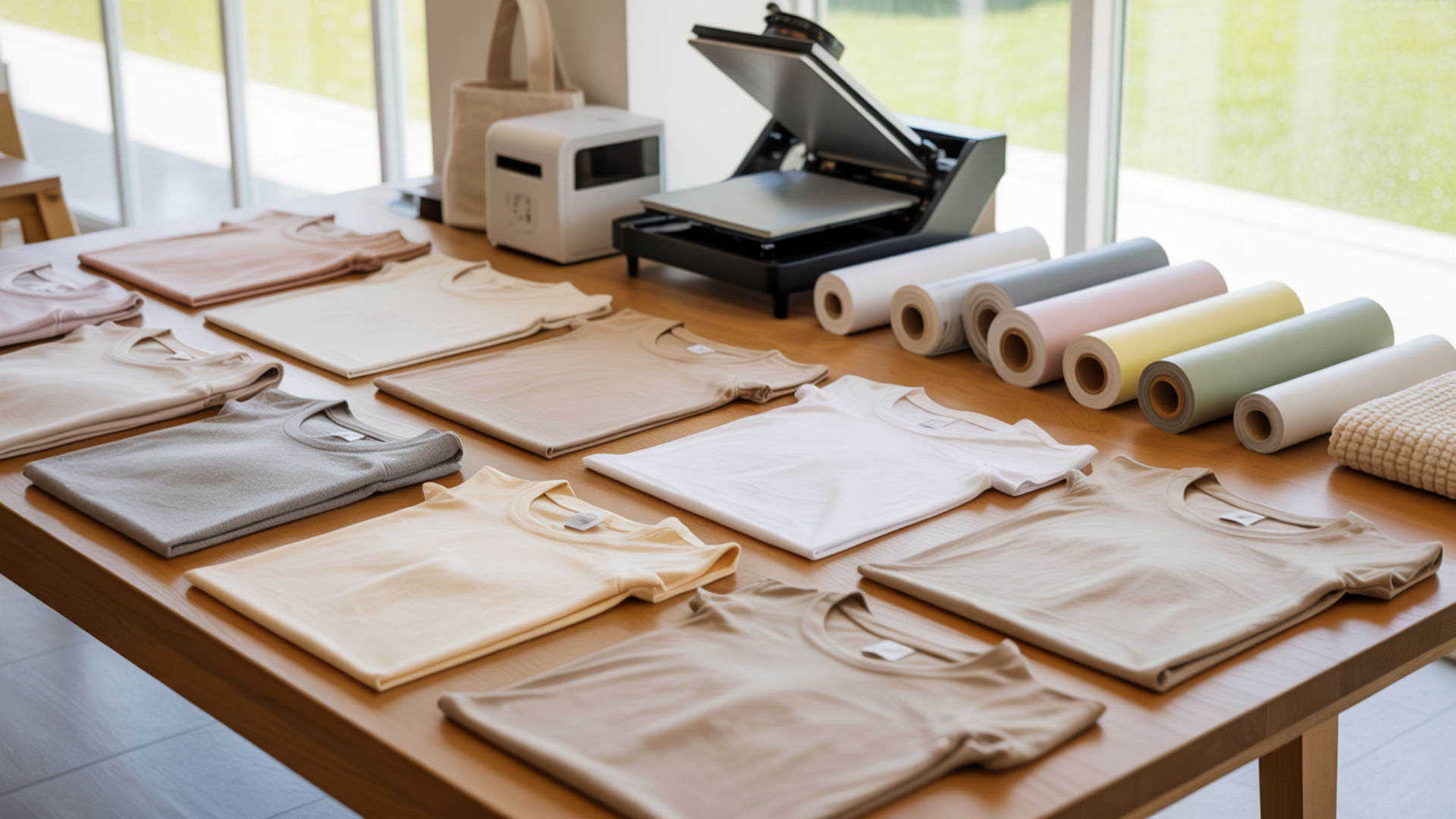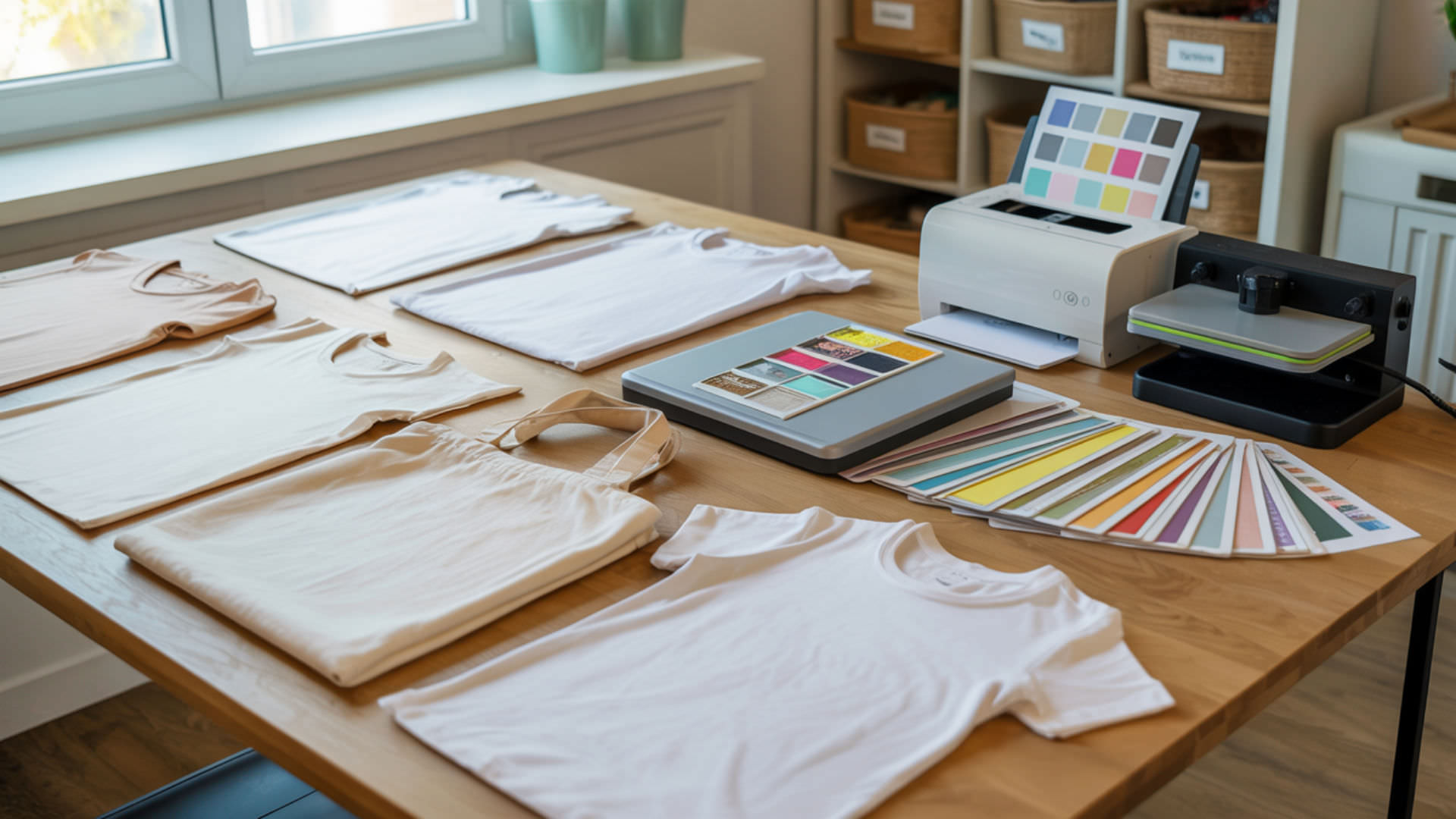Table of Contents
ToggleDirect-to-garment printing sprays aqueous pigment ink onto fabric surfaces using inkjet technology, while sublimation uses dye diffusion to infuse color into polyester fibers through a phase change process. Because direct-to-garment printing represents one of several decoration methods available to garment businesses, our comprehensive guide on sublimation vs other printing methods covers how it compares across key performance factors. For equipment recommendations based on inkjet printing technology, see our guide on the best printer for T-shirt printing.
Key Takeaways
- Sublimation’s dye diffusion bonds color permanently within polyester fibers, while DTG’s aqueous pigment ink sits on fabric surfaces.
- DTG excels on 100% cotton with pretreatment; sublimation requires 65%+ polyester content for acceptable results.
- DTG prints last 40–50 washes; sublimation prints last the garment’s lifetime without cracking or peeling.
Which printing method is actually cheaper, DTG or sublimation?

DTG requires a pretreatment solution for dark garments, adding $0.30–$0.50 per shirt, plus curing at 320°F for 90–120 seconds using heat and pressure. Sublimation skips pretreatment entirely, relying mainly on heat pressing at 380–400°F for 35–60 seconds. DTG startup costs run $10,000–$30,000 for commercial printers; sublimation entry systems start under $1,000 with converted inkjets.
How much should a DTG print cost?
A single DTG print costs $3–$8 depending on design size, ink coverage, and garment color. Aqueous pigment ink represents the largest consumable expense at $0.50–$2.00 per print for full-coverage designs. Pretreatment solution adds $0.30–$0.50 per dark garment. White ink for dark shirts doubles consumable costs because it requires heavier ink deposits for opacity.
How many DTG prints can you make?
Production throughput depends on printhead nozzle condition and curing capacity. Most DTG printers produce 10–25 shirts per hour for standard designs. Curing requires 90–120 seconds per garment at 320°F, creating bottlenecks. Nozzle maintenance—daily cleaning and weekly deep cleaning—prevents clogs that reduce output. Commercial systems with multiple platens achieve 30–50+ prints hourly.
Is sublimation genuinely better than DTG for certain materials?

Sublimation delivers superior results on polyester because dye molecules bond permanently within synthetic polymer chains. DTG performs best on cotton where pigment ink adheres to natural fiber surfaces. Neither method works universally—fabric compatibility determines which technology produces acceptable quality. Understanding fabric compatibility differences helps when comparing DTG to screen printing, which also favors cotton substrates.
Does DTG printing crack?
DTG prints can crack when aqueous pigment ink isn’t properly cured or when excessive ink creates thick layers. Print durability differences emerge from cure quality—under-cured prints crack after 10–20 washes. Proper curing at 320°F for the manufacturer’s recommended time bonds ink to fibers. Avoiding over-inking and following wash instructions prevents premature cracking.
⫸ Click Here For Best Selling Sublimation Printers And Products ⫷What are the disadvantages of DTG printing?
DTG’s main workflow drawbacks include mandatory pretreatment solution for dark garments and extended curing times that limit throughput. White ink maintenance demands daily agitation to prevent settling. Equipment costs exceed $10,000 for commercial systems. Polyester fabrics produce inconsistent results due to dye migration at curing temperatures, limiting DTG to cotton-focused applications.
How long do DTG shirts typically last compared to sublimation?

Print durability differences stem from how each method bonds color to fabric. Sublimation’s dye diffusion makes color part of the polyester fiber structure permanently—prints last the garment’s lifetime without degradation. DTG’s surface-deposited ink fades gradually over washes because pigment particles sit on top rather than integrating into fibers.
How many washes does a DTG print last?
Properly cured DTG prints using quality aqueous pigment ink survive 40–50 washes before noticeable fading. With careful handling—washing inside-out in cold water, avoiding harsh detergents, and air drying—prints can exceed 50+ washes. Sublimation prints on polyester show no degradation after hundreds of washes because the dye is part of the fiber.
Does DTG printing peel?
DTG prints peel when pretreatment solution is applied unevenly or when curing temperature and time fall short of requirements. Proper pretreat coverage creates a receptive surface for ink adhesion; gaps cause peeling in those areas. Correct curing at 320°F for 90–120 seconds bonds ink permanently. Well-produced DTG prints should never peel under normal use.
What makes DTG printing more expensive than other methods?

DTG cost drivers include pretreatment machine investment ($500–$2,000), frequent printhead nozzle maintenance, and high aqueous pigment ink consumption—especially white ink for dark garments. Commercial DTG printers cost $10,000–$30,000. White ink alone can cost $200–$400 per liter and requires 2–3x more volume than CMYK colors for adequate opacity on dark fabrics. According to the CDC’s Agency for Toxic Substances and Disease Registry, volatile organic compounds used in industrial processes can contribute to indoor air exposure risks when ventilation and handling are not properly managed.[1]
Does DTG printing fade?
DTG prints fade when aqueous pigment ink isn’t fully cured or when garments are washed improperly. Under-cured prints lose vibrancy after 10–20 washes. Proper curing at 320°F for the recommended duration prevents premature fading. High-quality inks and correct pretreatment on dark garments maintain color vibrancy through 50+ wash cycles with proper care.
Is DTG printing high quality?
DTG delivers excellent image sharpness differences for photographic and complex multicolor designs using inkjet printing technology. Resolution reaches 1200+ DPI with smooth gradients and fine detail reproduction. Halftone-based image formation produces near-photographic quality on cotton. DTG excels at reproducing photographs, illustrations, and intricate graphics with unlimited colors per design.
Which printing method works better for different fabric types?

DTG works best on 100% cotton because natural fibers absorb aqueous pigment ink effectively. Blends with 80%+ cotton also perform well. Sublimation requires polyester content of at least 65% for acceptable dye penetration. For polyester applications, both sublimation and DTF printing offer alternatives—our DTF comparison explains the different bonding mechanisms. Fabric compatibility ultimately determines which method suits your product line. Research from the U.S. The Department of Agriculture explains how cotton fiber structure influences ink absorption and surface bonding, which is why DTG performs well on cotton while sublimation does not. [2]
Is DTG printing like vinyl?
DTG and vinyl differ in application and feel, though both involve surface deposits. DTG sprays aqueous pigment ink directly onto fabric—soft, breathable, and integrated into fibers. Vinyl applies a pre-cut polymer coating layer via heat press—thicker, more rigid, and sitting distinctly on top. DTG handles photographic detail; vinyl suits solid-color graphics and text.
Can you wash DTG printing?
DTG-printed garments require proper washing to maximize print durability differences over time. Machine wash inside-out in cold water below 30°C on gentle cycles. Avoid bleach and fabric softeners. Cure quality determines wash resistance—properly cured prints at 320°F maintain vibrancy through 50+ cycles. Air drying or low-heat tumble drying extends print life significantly.
How do you actually print with DTG step-by-step?

- Prepare the garment by removing wrinkles with a heat press for 3–5 seconds. This eliminates moisture and creates a flat printing surface for consistent ink application.
- Apply pretreatment solution evenly across the print area using a pretreatment machine or spray gun. Dark garments require pretreatment for white ink adhesion; light shirts may skip this step.
- Cure the pretreatment by heat pressing at 330°F for 30–40 seconds until dry to touch. This fixes the pretreatment into fibers and prepares the surface for inkjet printing.
- Load the garment onto the printer platen and send the design file. The DTG printer deposits aqueous pigment ink directly onto the fabric in CMYK plus white layers.
- Cure the printed design at 320°F for 90–120 seconds using a heat press. Proper curing temperature and time bond the ink permanently to fabric fibers for wash durability.
- Allow the garment to cool before folding or packaging. Cooling prevents ink smearing and ensures the cured print sets completely before handling.
Ready to choose between DTG and sublimation?
Your fabric requirements determine which method fits your business. DTG’s aqueous pigment ink excels on cotton with photographic detail and unlimited colors. Sublimation’s dye diffusion delivers permanent, vibrant results on polyester with zero texture. Evaluate your product line’s material composition, then invest in the technology that matches your primary substrate.
Frequently Asked Questions
What is better quality, DTF or DTG?
DTG often provides superior detail and color accuracy for photographic designs, with prints integrating softly into fabric fibers. DTF offers vibrant colors and works on more fabric types including polyester and cotton. DTG feels softer; DTF can feel slightly stiffer on large solid areas. Quality depends on design complexity and fabric compatibility requirements.
Is DTG printing breathable?
DTG prints are soft, breathable, and durable because aqueous pigment ink absorbs into natural fiber surfaces rather than forming a thick layer. The printed area maintains fabric flexibility and airflow. DTG works best on cotton, bamboo, and other natural materials where fibers absorb ink effectively, preserving the garment’s original breathability characteristics.
What fabric is best for DTG?
100% ringspun cotton delivers the most vibrant, opaque DTG results because fibers absorb ink thoroughly. Cotton blends with 80%+ cotton content also perform well. Tri-blends produce a softer, vintage look with less opacity. Avoid 100% polyester—dye migration at curing temperatures causes color distortion. Fabric compatibility directly affects print quality and longevity.
Can DTG print photos?
Direct-to-garment printing excels at reproducing photographs, illustrations, and intricate full-color designs. DTG’s inkjet technology achieves 1200+ DPI resolution with smooth gradients and fine detail. The method handles unlimited colors per design without additional setup costs. Best results occur on 100% cotton shirts where pretreatment solution ensures proper ink adhesion and color vibrancy.
Why does DTG look faded?
Faded DTG prints typically result from incorrect curing temperature or time, insufficient ink application, or missing pretreatment on dark garments. Under-curing at temperatures below 320°F prevents proper ink bonding. Inadequate white ink coverage on dark shirts produces a washed-out appearance. Quality inks, proper pretreatment, and correct curing eliminate fading issues.
References
- (n.d.). Agency for Toxic Substances and Disease Registry | ATSDR. https://www.atsdr.cdc.gov/toxfaqs/tfacts10.pdf
- Runtime error. (n.d.). Runtime Error. https://www.ars.usda.gov/southeast-area/new-orleans-la/southern-regional-research-center/cotton-quality-and-innovation-research/














